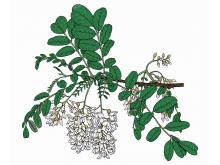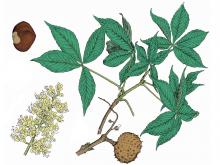Trees, Shrubs and Woody Vines
Media

Species Types
Scientific Name
Fraxinus americana
Description
White ash leaves turn shades of yellow and purple in fall, and that is one reason it has been a popular landscaping tree. Many birds and mammals feed on the paddle-shaped seeds.
Media

Species Types
Scientific Name
Carya texana
Description
Black hickory's nut, like that of the pignut hickory, is awfully hard to crack. Because rural Ozarkers noticed their hogs had no trouble extracting the sweet kernels, both species came to be called "pignut hickories."
Media

Species Types
Scientific Name
Rhus spp.
Description
Sumacs are shrubs or small trees that often form colonies from their creeping, branched roots. The foliage usually turns brilliant shades of red in early autumn. The clusters of berrylike fruits are red.
Media

Species Types
Scientific Name
Robinia pseudoacacia
Description
Black locust, a member of the bean family, is easy to appreciate in May and June, when its showy white clusters of flowers perfume the breeze with their sweet smell. Bees like the flowers, too.
Media

Species Types
Scientific Name
Carya spp.
Description
Hickories are an important part of Missouri’s oak-hickory woodlands and forests. They have tremendous economic value, too. Learn about the nine species of hickory found in Missouri.
Media

Species Types
Scientific Name
Zanthoxylum americanum
Description
Common prickly ash is a thicket-forming shrub or small tree. Its compound leaves resemble of those of ash trees, but it’s in a different family. Pairs of stout, curved prickles occur at each node. Scattered statewide, but less common in the Ozarks.
Media

Species Types
Scientific Name
Fraxinus spp.
Description
Missouri has six species of ashes that you might find in natural settings. They have been very popular as shade trees, and their wood is famously useful. Ash trees of all the species in North America are currently being killed by the invasive, nonnative emerald ash borer.
Media

Species Types
Scientific Name
Aesculus glabra
Description
Ohio buckeye is one of the first trees to leaf out in spring, and its palmately compound leaves make it look somewhat coarse textured. But most of all, buckeyes are known for buckeyes! People often carry these shiny brown seeds in their pockets for luck.
See Also
About Trees, Shrubs and Woody Vines in Missouri
There are no sharp dividing lines between trees, shrubs, and woody vines, or even between woody and nonwoody plants. “Wood” is a type of tissue made of cellulose and lignin that many plants develop as they mature — whether they are “woody” or not. Trees are woody plants over 13 feet tall with a single trunk. Shrubs are less than 13 feet tall, with multiple stems. Vines require support or else sprawl over the ground.





















